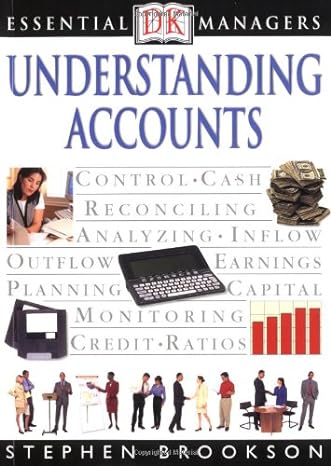Question
Accounts Receivable Bad Debts Recording Bad Debt Percentage of sales Aging of receivables Write off Bad Debt Recovery of Bad Debt QS 8-1Entries for sale
Accounts Receivable Bad Debts
Recording Bad Debt
Percentage of sales
Aging of receivables
Write off Bad Debt
Recovery of Bad Debt
QS 8-1Entries for sale on credit and subsequent collection LO1
Journalize the following transactions for Kimmel Company (assume a perpetual inventory system):
a.
On March 1, Kimmel Company sold $40,000 of merchandise costing $32,000 on credit terms of n/30 to JP Holdings.
b. On March 27, JP Holdings paid its account in full.
QS 8-5Adjusting entry to estimate bad debts--percentage of sales L02,3
Lexton Company uses the allowance method to account for uncollectible accounts receivable. At year-end, October 31, it was estimated that 0.6% of net credit sales were uncollectible based on past experience. Net sales were $690,000, of which 2/3 were on credit. Record the entry at year-end to estimate uncollectible receivables.
QS 8-6Adjusting entry to estimate bad debts--aging of receivables L02,3
Dim Sum Foods has accounts receivable of $260,000 and the allowance for doubtful accounts has a credit balance of $6,000. Based on analyzing the aging of the accounts receivable, management determined that the appropriate ending balance in the allowance for doubtful accounts at year-end, December 31, should be $26,000.
- Draw a T-account for the allowance for doubtful account and fill it in with all of the given information.
- Determine the amount of bad debt expense that needs to be recorded C. Prepare the adjusting journal entry to record the estimated bad debts at year-end.
QS 8-7Adjusting entry to estimate bad debts--percentage of receivables L02,3
Foster Company uses the allowance method to account for uncollectible accounts receivable. At year-end, December 31, the unadjusted balance in the Allowance for Doubtful Accounts was $450 credit.
Based on past experience, it was estimated that 2.5% of the Accounts Receivable balance of $640,000 was uncollectible. Record the adjusting entry to estimate bad debts at December 31.
Exercise 8-4Write-off and subsequent partial recovery LO2
Foster Company uses the allowance method to account for uncollectibles. On October 31, it wrote off a $1,200 account of a customer, Gwen Rowe. On December 9, it received an $800 payment from Rowe.
a. Make the appropriate entry or entries for October 31. b.
Make the appropriate entry or entries for December 9.
Exercise 8-Allowance for doubtful accounts LO2,3
At the end of its annual accounting period, Midi Company estimated its bad debts as 0.75% of its $1,750,000 of credit sales made during the year. On December 31, Midi made an addition to its Allowance for Doubtful Accounts equal to that amount. On the following February 1, management decided that the $2,600 account of Catherine Hicks was uncollectible and wrote it off as a bad debt. Four months later, on June 5, Hicks unexpectedly paid the amount previously written off. Give the journal entries required to record these transactions
Exercise 8-7Receivables, allowance for doubtful accounts, write-off, and subsequent recovery LO1,2,3
Outdoor Equipment (O) sells camping equipment. On December 1, the accounts receivable account had a balance of $50,000, the bad debt expense account had a balance of $0, and the allowance for doubtful account had a credit balance of $5,000. Journalize the remaining journal entries for the 2017 year.
Dec.
2
Sold tents for $5,000 on account with a cost of $2,500.
20
Determined that the total accounts of Rocky Co. with an accounts receivable balance of $1,200 and Grouse Co. with an accounts receivable balance of $2.500 were uncollectible and needed to be written off.
23
31
Unexpectedly received payment from Grouse Co. for $2,500.
Estimated that 10% of accounts receivable recorded to date would be uncollectible.
Required
1. Prepare journal entries to record the transactions. Note: Write-off of uncollectible accounts for Rocky Co. and Grouse Co. should be posted separately.
Draw and fill in the T-account for accounts receivable, bad debt expense, and allowance for doubtful accounts. Determine the ending balance for each account
Step by Step Solution
There are 3 Steps involved in it
Step: 1

Get Instant Access to Expert-Tailored Solutions
See step-by-step solutions with expert insights and AI powered tools for academic success
Step: 2

Step: 3

Ace Your Homework with AI
Get the answers you need in no time with our AI-driven, step-by-step assistance
Get Started


